Illustrations of the life of Martin Luther
Engraved in line after Original Paintings by L. P- H. with letterpress descriptions by T. H. Werle d' Anbignè D. D. Autor of the History of the Reformation of the Sixteenth Century.
Autor: Labouchere, P. H. (?-?), Erscheinungsjahr: 1862
Themenbereiche
Enthaltene Themen: Reformation, Reformationszeit, Reformatoren, Martin Luther, Melanchthon, Wittenberg, Wartburg, Eisenach,
PREFACE
The epoch of the Reformation is, next to the epoch of the Gospel, that which furnishes history with its brightest page. By restoring to fallen Christendom the doctrine and the life of apostolic times, the Reformation has achieved a mighty work, secured the future development of humanity, and prepared, for the nations who receive it, a reign of intellectual light, liberty, morality, order, and activity.
Roman-catholicism is a religion of the Middle Ages. Its empty superstitions, its perishable institutions, its church, mostly without spirit and without life, cannot exist in modern times: the Gospel must now make all things new. Already, if we compare Protestant with Romish nations - England and Spain for instance - we may discern a remarkable difference between them. That comes from the Reformation.
It is important, therefore, that this great epoch should be better known; nay more, it must become popular: and for that purpose, it is fit that it should be not only described in books, but represented by the productions of art. It is this end we have in view in laying before the public a few scenes in the life of the great Reformer.
This design has been conceived and executed by an eminent artist, whose name and family are equally known in France, England, and Holland, and who has already acquired an honourable reputation by his former works, especially by his two beautiful pictures of “Luther, Melanchthon, Pomeranus, and Cruciger translating the Bible", and "The Conference at Geneva in 1549." My estimable friend, M. Labouchere, desired me to describe with the pen the scenes which he has so ably depicted with his pencil. Although I felt my insufficiency for such a task, I did not think it right to be deaf to his repeated entreaties.
I have merely added some rough outlines to the finished work of M. Labouchere; for I know that, in publications of this kind, the whole attention is directed to the plates, and that the letter-press holds a secondary rank. Although it may be my fate not to be read, I have, nevertheless, had pleasure in carefully tracing these historic scenes of the Reformation of Luther. I thought I could not do better than take as my guide an expression of Luther's: "An animated narrative is like a picture, and is fixed far more deeply in the mind than an abstract doctrine."
History ought to be written in an historical manner, according to the rule that everything should be treated according to its nature. History must live again in the eyes of those who study it, and they must be eye-witnesses of the things they are told. This is more especially necessary when we have to deal with a few detached scenes, and not a continuous narrative. For a scene to have indispensable truthfulness and life, it is allowable, and even necessary, to add here a shadow, there a light, in harmony with the design and the general arrangement to give the touches required to complete the resemblance.
The severe muse of history excludes all that has not really taken place: it is not strictly the same with pictures of the past. Here we must take truth rather than reality for our guide.
There are museums where statues are exhibited just as they have been found, that is to say, mutilated, without arms, perhaps even without heads. There are other museums where the statues are restored to what they must originally have been, where the missing limbs are replaced according to the analogy of those that are left. This is what the historic picture does.
And yet, while referring the reader, fond of history strictly written, to my work on the Reformation of the Sixteenth Century, I may add that the scenes here laid before him are true historic scenes.
I have only now to express a desire that this publication, even while interesting its readers, may contribute, in some small degree, to make true Protestantism better known. Some one of these pictures may reveal the inner forces which have in modem times restored the living religion of the apostolic ages; while another may manifest the firmness with which its purity ought to be maintained. These two things truth and life are necessary, so that amid the divers forms, more or less defective, of religious society, evangelical Christianity may accomplish the task which God has assigned it, and be the true, powerful, and salutary religion.
This, to my mind, is the prime interest of human kind.
MERLE D'AUBIGNE.
Eaux Vives, Geneva.
* * * * *
LIST OF ILLUSTRATIONS.
THE SCHOOL - 1488 - 1497.
POVERTY (ST. GEORGE'S SQUARE, EISENACH). - 1498.
THE BIBLE (UNIVERSITY LIBRARY AT ERFURT). - 1503.
THE CALL FROM GOD (GATE OF THE UNIVERSITY LIBRARY, ERFURT). - 1505.
HUMILIATION (GATE OF THE AUGUSTINE MONASTERY AT ERFURTH). - 1505.
THE INDULGENCES; OR, THE NINETY-FIVE PROPOSITIONS (IN FRONT OP ALL SAINTS' CHURCH, WITTEMBERG). 31. OCTOBER, 1517.
LUTHER BURNING THE POPE'S BULL (IN FRONT OF THE EAST GATE OF WITTEMBERG). 10. DECEMBER, 1520.
THE DIET OF WORMS (HALL OF THE DIET). 13. APRIL, 1521.
LUTHER ON THE WARTBURG. 4. MAY, 1521 4. MARCH, 1522.
THE MARRIAGE (AMSDORFF'S HOUSE AT WITTEMBERG). 13. JUNE, 1525.
DOMESTIC LIFE (A ROOM IN LUTHER'S HOUSE AT WITTEMBERG; ON THE WALLS ARE PORTRAITS OF THE REFORMER'S FRIENDS.
VICTORY IN DEATH (EISLEBEN). THE NIGHT OF THE 18. OF FEBRUARY, 1546.
The epoch of the Reformation is, next to the epoch of the Gospel, that which furnishes history with its brightest page. By restoring to fallen Christendom the doctrine and the life of apostolic times, the Reformation has achieved a mighty work, secured the future development of humanity, and prepared, for the nations who receive it, a reign of intellectual light, liberty, morality, order, and activity.
Roman-catholicism is a religion of the Middle Ages. Its empty superstitions, its perishable institutions, its church, mostly without spirit and without life, cannot exist in modern times: the Gospel must now make all things new. Already, if we compare Protestant with Romish nations - England and Spain for instance - we may discern a remarkable difference between them. That comes from the Reformation.
It is important, therefore, that this great epoch should be better known; nay more, it must become popular: and for that purpose, it is fit that it should be not only described in books, but represented by the productions of art. It is this end we have in view in laying before the public a few scenes in the life of the great Reformer.
This design has been conceived and executed by an eminent artist, whose name and family are equally known in France, England, and Holland, and who has already acquired an honourable reputation by his former works, especially by his two beautiful pictures of “Luther, Melanchthon, Pomeranus, and Cruciger translating the Bible", and "The Conference at Geneva in 1549." My estimable friend, M. Labouchere, desired me to describe with the pen the scenes which he has so ably depicted with his pencil. Although I felt my insufficiency for such a task, I did not think it right to be deaf to his repeated entreaties.
I have merely added some rough outlines to the finished work of M. Labouchere; for I know that, in publications of this kind, the whole attention is directed to the plates, and that the letter-press holds a secondary rank. Although it may be my fate not to be read, I have, nevertheless, had pleasure in carefully tracing these historic scenes of the Reformation of Luther. I thought I could not do better than take as my guide an expression of Luther's: "An animated narrative is like a picture, and is fixed far more deeply in the mind than an abstract doctrine."
History ought to be written in an historical manner, according to the rule that everything should be treated according to its nature. History must live again in the eyes of those who study it, and they must be eye-witnesses of the things they are told. This is more especially necessary when we have to deal with a few detached scenes, and not a continuous narrative. For a scene to have indispensable truthfulness and life, it is allowable, and even necessary, to add here a shadow, there a light, in harmony with the design and the general arrangement to give the touches required to complete the resemblance.
The severe muse of history excludes all that has not really taken place: it is not strictly the same with pictures of the past. Here we must take truth rather than reality for our guide.
There are museums where statues are exhibited just as they have been found, that is to say, mutilated, without arms, perhaps even without heads. There are other museums where the statues are restored to what they must originally have been, where the missing limbs are replaced according to the analogy of those that are left. This is what the historic picture does.
And yet, while referring the reader, fond of history strictly written, to my work on the Reformation of the Sixteenth Century, I may add that the scenes here laid before him are true historic scenes.
I have only now to express a desire that this publication, even while interesting its readers, may contribute, in some small degree, to make true Protestantism better known. Some one of these pictures may reveal the inner forces which have in modem times restored the living religion of the apostolic ages; while another may manifest the firmness with which its purity ought to be maintained. These two things truth and life are necessary, so that amid the divers forms, more or less defective, of religious society, evangelical Christianity may accomplish the task which God has assigned it, and be the true, powerful, and salutary religion.
This, to my mind, is the prime interest of human kind.
MERLE D'AUBIGNE.
Eaux Vives, Geneva.
* * * * *
LIST OF ILLUSTRATIONS.
THE SCHOOL - 1488 - 1497.
POVERTY (ST. GEORGE'S SQUARE, EISENACH). - 1498.
THE BIBLE (UNIVERSITY LIBRARY AT ERFURT). - 1503.
THE CALL FROM GOD (GATE OF THE UNIVERSITY LIBRARY, ERFURT). - 1505.
HUMILIATION (GATE OF THE AUGUSTINE MONASTERY AT ERFURTH). - 1505.
THE INDULGENCES; OR, THE NINETY-FIVE PROPOSITIONS (IN FRONT OP ALL SAINTS' CHURCH, WITTEMBERG). 31. OCTOBER, 1517.
LUTHER BURNING THE POPE'S BULL (IN FRONT OF THE EAST GATE OF WITTEMBERG). 10. DECEMBER, 1520.
THE DIET OF WORMS (HALL OF THE DIET). 13. APRIL, 1521.
LUTHER ON THE WARTBURG. 4. MAY, 1521 4. MARCH, 1522.
THE MARRIAGE (AMSDORFF'S HOUSE AT WITTEMBERG). 13. JUNE, 1525.
DOMESTIC LIFE (A ROOM IN LUTHER'S HOUSE AT WITTEMBERG; ON THE WALLS ARE PORTRAITS OF THE REFORMER'S FRIENDS.
VICTORY IN DEATH (EISLEBEN). THE NIGHT OF THE 18. OF FEBRUARY, 1546.
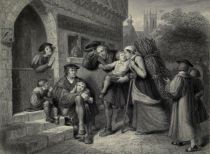
Luther, die Schule
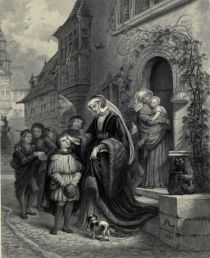
Luther, Armut
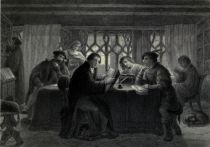
Luther, die Bibel
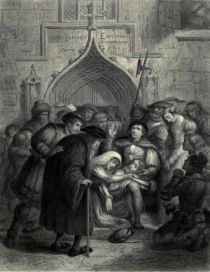
Luther, der Anruf von Gott
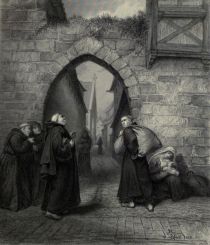
Luther, Erniedrigung
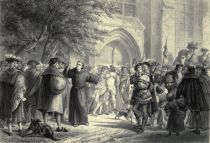
Luther, Anschlag der 95 Thesen
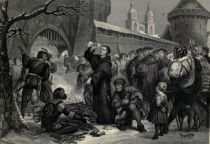
Luther, Verbrennung der päpstlichen Bulle
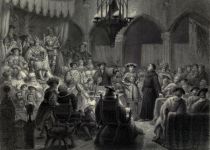
Luther, der Reichstag zu Worms
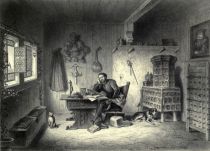
Luther, Lutherzimmer auf der Wartburg
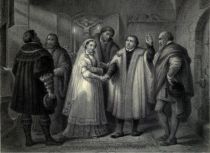
Luther, Die Hochzeit
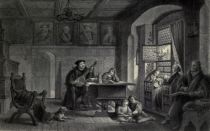
Luther, Haus- und Familienleben
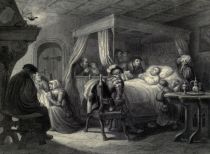
Luther, Auf dem Sterbebett